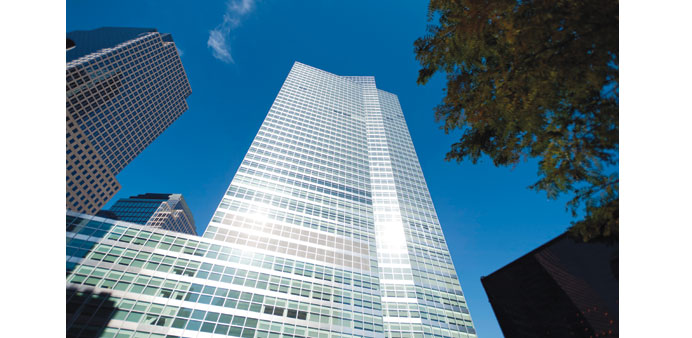Goldman Sachs Group headquarters in New York. Goldman Sachs and Wells Fargo will be among the first to benefit as a stronger US economy prompts the Federal Reserve to raise rates for the first time in almost a decade, according to Carl Eichstaedt, who runs the $15.3bn Western Asset Core Plus Bond Fund.
Bloomberg
New York
As an unprecedented era of rock-bottom US interest rates comes to an end, finding a bond fund manager who will protect your money is more crucial than ever.
One of the best in the business says that, right now, there’s no better way to do that than by scaling back on Treasuries, betting big on US banks and taking some risk in emerging markets such as Mexico.
Carl Eichstaedt, who runs the $15.3bn Western Asset Core Plus Bond Fund, says Goldman Sachs Group and Wells Fargo & Co will be among the first to benefit as a stronger US economy prompts the Federal Reserve to raise rates for the first time in almost a decade. More stringent regulations also mean financial firms are taking fewer risks for the sake of shareholders these days.
“It’s a much less risky business model than it was during the crisis,” said the 55-year-old Eichstaedt, whose fund has about 13% of its assets in financial bonds - far more than the benchmark allocation of about 8%, data compiled by Bloomberg show. “It’s not necessarily good for the equity holder, but it’s music to the ears of a bondholder.”
Eichstaedt, named 2014 US fixed-income fund manager of the year by Morningstar Inc, backs his willingness to put on large positions with a lofty track record. His fund, which focuses on intermediate US investment-grade debt but has the option to invest in junk bonds and emerging markets, has returned 1.7% in 2015, data compiled by Bloomberg show.
That’s better than 98% of similar funds, which are barely up this year. He’s not just a one-year wonder. The fund has an posted an average annual return of 4.5% over the past five years, beating 94% of rivals.
The stakes could hardly be higher than they are right now. After years of ultra-loose policies by the world’s central banks propelled bonds of all types, managers who are paid for their skill are suddenly falling short as those same policies start to diverge.
And with the Fed about to end its zero-rate policy, the European Central Bank contemplating more-aggressive stimulus and China trying to spur flagging growth, the winners and losers have become more pronounced. Actively managed bond funds have gained just 0.7% in the past 12 months, about half the return for those that track indexes, data compiled by Bloomberg show. That’s a stark contrast to the previous years, when active managers outperformed.
Eichstaedt, who cut this teeth as a bond trader at Chemical Bank (now part of JPMorgan Chase & Co) and did a stint at Pacific Investment Management Co before joining Western Asset in 1994, says the Fed will start tightening in December and raise rates to 1% by the end of next year as the economy strengthens. The central bank has kept borrowing costs close to zero since cutting them in 2008 to combat the financial crisis.
While his estimate for how high rates will rise in 2016 is lower than the Fed’s own projection of 1.375%, it’s still above what fixed-income traders are pricing in. They see the effective rate averaging about 0.79%.
The probability the Fed will increase its benchmark by its Dec. 15-16 meeting is 70%, according to futures data compiled by Bloomberg. The calculation is based on the assumption the effective fed funds rate will average 0.375% after liftoff, compared with the current range of zero to 0.25%.
“This recovery has been begrudgingly slow and haphazard, but we think it’s here to stay,” said Eichstaedt, who also holds bonds of Bank of America Corp, Citigroup and JPMorgan, data compiled by Bloomberg show.
Stronger economic growth will boost loan demand while higher US benchmark rates will bolster banks’ net interest margins, he said.
Besides financial bonds, Eichstaedt also sees opportunities in emerging markets, whose currencies have been among the hardest hit by a year-and-a-half rally in the dollar. Based on its holdings at the end of September, about 3.7% of his fund’s assets are currently invested in debt from Mexico, the most outside the US
Eichstaedt anticipates peso-denominated bonds will benefit as higher interest rates in Mexico help the currency recover from its 11% decline this year. Mexican central bank officials have repeatedly signalled they’ll tighten along with the Fed to preserve the nation’s interest-rate advantage and keep foreign investors from pulling out capital.
Confidence the Fed won’t upend the US economy as it nudges rates higher has also pushed investors back into risk assets, said Eichstaedt, who’s “underweight” Treasuries.
After lagging behind US government bonds in the first nine months of the year, emerging market sovereign debt has gained 2.5%, junk-rated company bonds have advanced 1.6% and investment-grade corporate securities have broken even this quarter, index data compiled by Bloomberg show. Treasuries have lost about 1%.
Joe Higgins, who manages $3.6bn at TIAA-CREF Investment Management in New York, says the Fed’s “data dependent” rate increases will be seen as a sign of confidence in the economy’s ability to generate jobs growth and consumer demand. Unlike Eichstaedt, Higgins prefers to focus more on debt issued by consumer-based companies in his TIAA-CREF Social Choice Bond Fund, which has outperformed 97% of similar funds in the past year and 98% over the past three years.
That’s because continued growth will pull more Americans into the labor force and fuel spending, while the increasing pool of returning workers will keep wage inflation low.
Some of his biggest consumer holdings at the end of the third quarter included debt issued by Harley-Davidson and Ford Motor Co. He also favours asset-backed securities from Domino’s Pizza, which are secured by franchise royalties.
“We can’t have animal spirits and a move to the more traditional pre-crisis economy until someone, somewhere demonstrates confidence,” said Higgins, 51. “We are seeing a bit of confidence in consumer spending. We still haven’t seen it in the corporate suite.”



